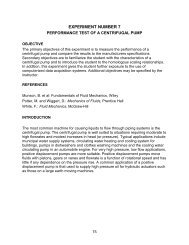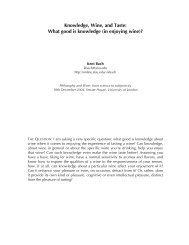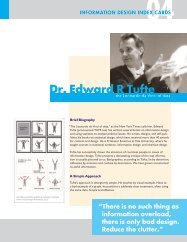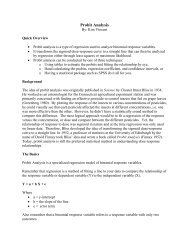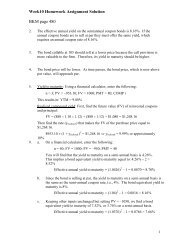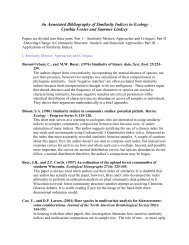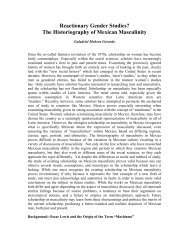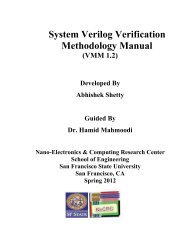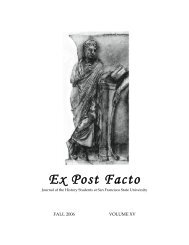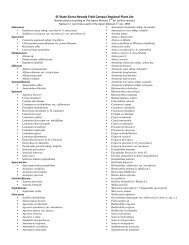Molecular Phylogeny of the Chipmunks Inferred from Mitochondrial ...
Molecular Phylogeny of the Chipmunks Inferred from Mitochondrial ...
Molecular Phylogeny of the Chipmunks Inferred from Mitochondrial ...
You also want an ePaper? Increase the reach of your titles
YUMPU automatically turns print PDFs into web optimized ePapers that Google loves.
344 PIAGGIO AND SPICER<br />
FIG. 5. Graph showing <strong>the</strong> distribution <strong>of</strong> branch lengths (generated <strong>from</strong> <strong>the</strong> maximum-likelihood tree inferred <strong>from</strong> a<br />
GTRIGestimated base frequencies model) within and between Tamias subgenera and o<strong>the</strong>r sciurid genera. This distribution demonstrates<br />
that <strong>the</strong> divergences between Tamias subgenera are equivalent to divergences between o<strong>the</strong>r sciurid genera, supporting <strong>the</strong> elevation<br />
<strong>of</strong> Tamias subgenera to three genera, Neotamias, Tamias, and Eutamias (Jameson, 1999).<br />
DISCUSSION<br />
Ancestral taxon <strong>of</strong> chipmunks. The systematics <strong>of</strong><br />
chipmunks has undergone many revisions based on<br />
bacular, morphological, allozyme, chromosomal, and<br />
host–ectoparasite data sets (White, 1953a; Nadler and<br />
Block, 1962; Nadler, 1964; Sutton and Nadler, 1969;<br />
Nadler et al., 1977; Levenson and H<strong>of</strong>fmann, 1984;<br />
Levenson et al., 1985; Oshida and Yoshida, 1994;<br />
Jameson, 1999). The results <strong>of</strong> <strong>the</strong>se studies have focused<br />
debate mainly over which species is most ancestral,<br />
where this ancestor arose, and how it dispersed.<br />
Some authors support an idea that an ancestral stock<br />
arose in Asia and spread to North America (Moore,<br />
1961; Nadler, 1964; Nadler et al., 1969, 1977; Sutton<br />
and Nadler, 1969; Ellis and Maxson, 1979; Jameson,<br />
1999). O<strong>the</strong>r authors cite evidence supporting a dispersal<br />
<strong>of</strong> ancestral stock <strong>from</strong> North America into Asia<br />
(Black, 1963, 1972; Nadler et al., 1985). Additionally,<br />
some authors indicate that it is possible that <strong>the</strong> ancestral<br />
stock arose in <strong>the</strong> Holarctic mesophytic forests<br />
and differentiated across Asia and North America<br />
(Levenson et al., 1985).<br />
The molecular data appear to show that T. sibiricus<br />
and T. striatus are sister taxa to <strong>the</strong> rest <strong>of</strong> <strong>the</strong> Tamias<br />
species, but do not distinguish which evolved first or <strong>the</strong><br />
direction <strong>of</strong> migration. On some level this is not easily<br />
resolved or important to <strong>the</strong> overall evolution <strong>of</strong> <strong>the</strong><br />
Tamias species in western North America. As Allen<br />
(1891) stated, “<strong>from</strong> <strong>the</strong> extreme susceptibility <strong>of</strong> this<br />
plastic group (chipmunks) to <strong>the</strong> influences <strong>of</strong> <strong>the</strong> environment,<br />
it is one <strong>of</strong> <strong>the</strong> most instructive and fascinating<br />
groups among North American mammals. Whe<strong>the</strong>r <strong>the</strong><br />
type originated at some point in North America, or in <strong>the</strong><br />
nor<strong>the</strong>rn part <strong>of</strong> Eurasia, it is perhaps idle to speculate,<br />
but that it has increased, multiplied, spread and become<br />
differentiated to a wonderful degree in North America is



